| Fundamental Insights For Winning
By: Mark Dantonio - Michigan State University
Originally Published in: Nike 2013 Coach of the Year Clinic Manual - by Earl Browning I am not going to start with a lot of fill. I am going to start out with our basic philosophy for a clinic. We want you to be able to take a couple of things back you can use in your program. I am a defensive back coach by trade and played defensive back at the University of South Carolina. I am a defensive coordinator and head coach. What I want to talk about are some winning thoughts.You have to start out with your goals. What are you trying to achieve? These are our goals. It does not mean they are right or wrong. These are the goals for us right now. Family and Program Goals Lifelong Relationship with Players, Coaches, Staff and Team. If we can do that, we are successful. They have to know you will go to the wall for them. Some of my biggest thrills in football are not just from winning big football games, but having some of my past players come back to visit and spend some time with me. Graduate ALL Players with a Meaningful and Useful Degree from Michigan State University. Launch Their Career. Become Self Sufficient Men. To me, the last line is probably the most important. You are looking for role models and looking to build role models. Win! "Success!" Bowl Games - Big Ten Championship - BCS Game - Rose Bowl - National Champions. We want to win and win big. Positive Impact on our University, Alumni, Community, State, NCAA Football "World", The Entire World, and Prepare to be Self-Sufficient Men and Responsible Citizens. Everything we do is pointed to these goals, from the time you walk into our building. I tell our guys, we have a platform here, use this platform in a positive way. How do we get there? First we have to make good choices with people. We have to bring the right people into our program. Spartan Plan for Success Choices / Moral / Spiritual Family (Trust) Family is the biggest support they have as a player. When things go bad or a player is looking for support, they are going to turn to their family first. It does not matter if it is a high school player or a player at the college level or even at the pro level. If things go bad, a player is going to turn to the people who are closest to them. Probably even more so at the high school level, you have to have a level of trust with your players. If they do not trust you, that is when the level of communication breaks down and things start to spin out of control. Discipline and Maturity If you have a problem with discipline, you have a problem with maturity. The more discipline you have, the more maturity you have as an individual and the further you are going to go in life. The more discipline and maturity you have the better you are going to handle problems. That is what this is all about, handling problems. Resources (Football, Academic, Social) We want to create chemistry in our locker room. You have to keep it fresh. You cannot just do everything the same way. Just like at a football clinic, if everyone talked about the same things in the same way it would be stale. We would lose your attention and lose you as an audience. Everyone would get complacent. It is the same thing with a team. You have to change up things and keep it fresh. You cannot always just grind them down. It is the same thing with the coach. You have to always be fresh to stay motivated. We have a Mission Statement. I let the team develop their own Mission Statement each year. This is what our team had as a Mission Statement for the past year. We want to make sure it reflects what we are trying to accomplish. 2012 Mission Statement The Challenge: Work Hard, Live Right, and Graduate. Toughness The hardest steel is forged in the hottest fire. Hard Work We will carry ourselves with a relentless work ethic. We are the hardest workers in the country. Unity We will not approach this season as individuals. We grow together through every challenge we face. Brotherhood is formed through adversity, based on communication, and cemented in trust. Finish We make it a habit to finish everything we do, every workout, every drill, every practice, every game. Teams that finish are the teams that are committed to winning. We have a Unity Council we call Eagles. We try to find twelve guys who are the leaders on our football team. When you look up Eagles in the dictionary you will see a lot of great attributes that parallel into leadership. We use Eagles as a symbol of leadership. The Eagle:
We will vote on our Unity Council four or five times a year. The leadership may change as they move forward. We want to meet with this group in an environment that is special. This might be an office where you meet with your coaches or other important people. We want them to feel special because they are going to help drive our teams' direction. We meet once a week and we try to get things out on the table that are problems. Not the little things, but the big things. An example might be why are we not working together as a team? Who is the problem? How do we change the attitudes? We had to let one of our big defensive tackles go because he lied about a big issue. He was a three year starter for us. The Unity Council met and there were people who thought he should go and others who wanted him to stay. The important thing is we got all of the issues out on the table. I think this helped create a healthy atmosphere for us. One thing I can tell you about Michigan State right now is we have great chemistry on our team. This is a result of great leadership. A lot of it is tied to how they select each other. You cannot bounce back from adversity without great leadership. You will always have people on the fringe of the twelve who hope to be able to become part of the Unity Council. They might be some of the younger players but they see the importance of it and want to become a part of it. We have been doing this for the last three years and it is paying big dividends. We give our players a shield when they come into our program. We took this idea from a soldier who served in Iraq. We thought it was a great idea so we have used it for the past five years. On one side it says Excellence at the top. Below the word excellence it has three stars and below the stars it has three banners with the words Communicate, Commitment, and Trust written across them. Everybody who comes into our program gets a shield. If you want to be excellent in our program, you have to have a commitment to do it. The commitment is not easy. We talk about commitment a lot in our program. Once we have the commitment, we have to have communication. If you do not communicate well, that is when things start to break down and when problems start to happen. Everyone has to communicate, whether it is a player who is playing or a player who is not playing, or whether it is a family member or a coach. Is there a problem with a player and a coach? What is the problem? Identify the problem you have by communicating and then move forward. Then we move on to Trust. We build off of those three aspects on one side of the shield. We have mentor meetings where we assign a mentor for five or six players at a time. They cannot be the player's position coach. We get the players to list 1-4, who they want to be their mentor. We try to match them up with who they want. I think it is important they have somebody they can talk to that is different than their position coach. We want them to have somebody they can go to and spill their guts to a little bit. With their mentor, they develop a set of goals that are written down and are attainable. We keep a master list of mentors and who they have responsibility for. In each of our position groups, we have written down, what the most important thing is or the nuts and bolts of their position? As a guest coach sitting in our room, you should be able to determine what we are trying to get across. You should be able to tell what the most important aspect or technique they are teaching. I want them to be tangible as much as they can. I want them to list what the hard core realities are that they have to learn in order to be successful at their position. On the backside of the shied we have Michigan State University written across the top. Under that, we have 3 banners with the words Effort, Toughness, and Knowledge written across them. We always think we are going to give good effort. I encourage them to reach a little higher. The toughness aspect is mental as well as physical. This is a tough man's game. This is not some video game we are playing. I mention this to them all of the time. This is real life. You are going to have to block as a tight end. You are going to have to block the defensive end in the gap if we are going to be able to run the football. This is real life stuff and there is a lot of toughness involved in being a great football team. Knowledge is power. Experience is power. The more you plan for a game, the better you will be prepared for that game. If you can learn the ABC's of everything you do and build off of that foundation, you are going to be just fine. It is hard to get everything you need in just an hour of time with a coach at a clinic. My advice is to go to a college or another high school and spend a day or two with a coach to learn all of the nuances about the subject you want to learn about. You have to spend time and have a commitment about it. Then you can take it back home and implement it into something you feel will work with your personnel. You have to keep things fresh. If you do not, you will grind them down. This is both physically and mentally. Players like to laugh and joke around and have fun. They want to do different things. They do not like everything to be the same. If you get an unexpected snow storm, let them go play in the snow. When we went to the Gator Bowl in Orlando we had an alligator and we let it run. We wanted to give them something they would never forget. When the alligator bit the guy that is something he will never forget. We let our assistant coaches have the opportunity to speak to the entire team. I think you have to give your coaches the opportunity to step out and grow as a coach. It is empowering and we are going to do those things.
If the ball is in the middle of the field, the divider or the midpoint of his third, is one yard above the numbers . Which is ten yards from the sideline. If the ball is on the hash, the divider for the corner to the field is five yards above the numbers. This mark is halfway between the numbers and the hash. The corner to the boundary, his divider is at the bottom of the numbers. If we are playing 3 deep coverage, we want to squeeze the receiver based on the dividers. We align on the dividers and let us say at one by eight. The idea is to keep yourself in a good position relative to the one third concept. You need to know the dimensions of the football field. In college the bottom of the numbers are at seven yards from the boundary and the tops are nine yards. It is 19 yards to the hash marks from the boundary. In high school it is seventeen yards to the boundary. The distance between the hash marks is 13 and one third yards. In high school it is seventeen yards between the hash marks. If you want to defend the field, you have to know the dimensions. If you want to work the field both offensively and defensively, you have to know the dimensions. Your players have to know the dimensions. They need to know it is seven yards from the bottom of the numbers to the sideline and six and one half to the red line. What does this mean? We do not cover someone who is in the no cover zone. We want to be able to break into the no cover zone if a ball is thrown in that area. You have to be able to break for 3 yards if the quarterback throws a 7 yard pass. If a receiver is holding up at five yards, we do not want to get hung up on him, because somebody will be able to run the dig behind us. Offenses do that. They run at different levels. We are going to break downhill if a pass is thrown underneath into the no cover zone. Food for thought, when we talk about 3 Deep Seams, we cannot allow receivers to run in the seams. (Diagram #4) The seam is ten yards from the line of scrimmage. If the ball is in the middle of the field, then in high school, the seam is just outside the hash. The seam is three yards wide. You can play any type of 3 deep coverage, but you must keep the offense out of the seams. You can walk up to anybody around you and the weakest part of their shirt is the seam. If I come up to a big strong guy and rip off his shirt, it is going to come apart at the seams. The receiver can run into the area in front of the seam at five or six yards, that is not an issue. You cannot allow the receiver to run into the seam or come back to the seam. You have to bang him out of the way and make him run around you. If you are playing your midpoints, you are going to be able to break on the ball. If the ball is on the hash, the seam gets adjusted over a little bit.
The curl players should keep their butt at a 45 degree angle to the middle of the field at a 18 yard depth and reroute the #2 receiver into the seams at a 10 yard depth. Do not allow the #2 receiver through the middle of the field. The safety should be able to cover the shaded areas in 2 deep coverage. This is the difference, as far as our philosophy, between 3 deep and 2 deep zones. Tackling is an important part of football. We focus on these coaching points. We will coach the little things. If you are not coaching it, you are letting it happen. Tackling Coaching Points
You want to be in a position of power. The first step should be a power step. For any position you play on the football field, it all starts with bending your knees and the power step. You have to bend your knees. You cannot play straight legged. If the first thing you do as a defensive back or linebacker is drop your butt, then your weight is going back. It is wasted motion. Football is physics. If you are putting your weight on the back of your heels, it is wasted motion. You want to be in a position of power. If you are an offensive or defensive lineman and you take too large of a first step and get overextended, it is a big problem. Your position of power begins with the first step. When we are critiquing our players, the thing we start with is the first step.
Even if you are a fullback running the ball up the middle on an Iso play, you want to hit with your near shoulder and your near leg up.
Do Not Play In "Sections," Generate Power We grade our tackling each week. We either make the tackle or we do not. We just take how many tackles we make versus how many tackles we miss. We want to be at 90 percent. If we are at 90 percent then usually we have played very well. If we are at 70 percent, we have missed too many tackles. When we set up our tackling drills for practice we like to use the following progression. Tackling Drill Progressions
We try to put them in all of the positions they will face and get as many reps in practice as they can so they will be ready for it in a game. We want to put them in adverse situations where they must think to succeed. You have to ask yourself, is everything you are doing going to help you win. If it is not, get rid of it. Things which matter most must never be at the mercy of things which matter least. As far as practicing our special teams, we break down the components into the ABC's. We work on our special team ABC drills every day during the week. These are the base principles we want to ensure we focus on for each specific part of our special teams play. Special teams can win or lose football games. We emphasize special teams a lot in practice. Weekly Time Commitment for Special Teams.
As far as punting is concerned, we want the snap to be .75 seconds or less. From hand to foot for the punter should be 1.25 seconds or less. The key to great punt protection is a 2.0 second get off. The key to great punt coverage is 4.5 seconds or more of hang time as well as good punt placement. A coaching point on punt coverage we practice involves a defender bearing down on the punt receiver. We want to watch the receiver's hands and eyes. If the receiver's hands go up along with his eyes, he is ready to catch the ball. His hands will not go up until he is ready to catch the ball. If I am within ten yards of him and his hands go up, as a rule, I take the shot. I do not gather first, I take the shot. If I am a defender and outside of ten yards from him, I immediately throttle down when his hands go up. The reason is when he catches the ball, he will have time to make a move and run by me, if I am running full speed out of control and I do not throttle down. If I am within ten yards, I have time to make the hit before he makes his move. If the hands are down and you are outside of the ten yards, keep closing. You still have to be concerned with the halo area but we have found this works for us. Thank you. If you can take two or three things from this to make you a better football coach or a better football team, then it has been a positive. I appreciate everyone for coming down to listen. If we can do anything for you up at Michigan State just let us know. Football is a great game and parallels life quite a bit. Thank you so much. Go Green!
|
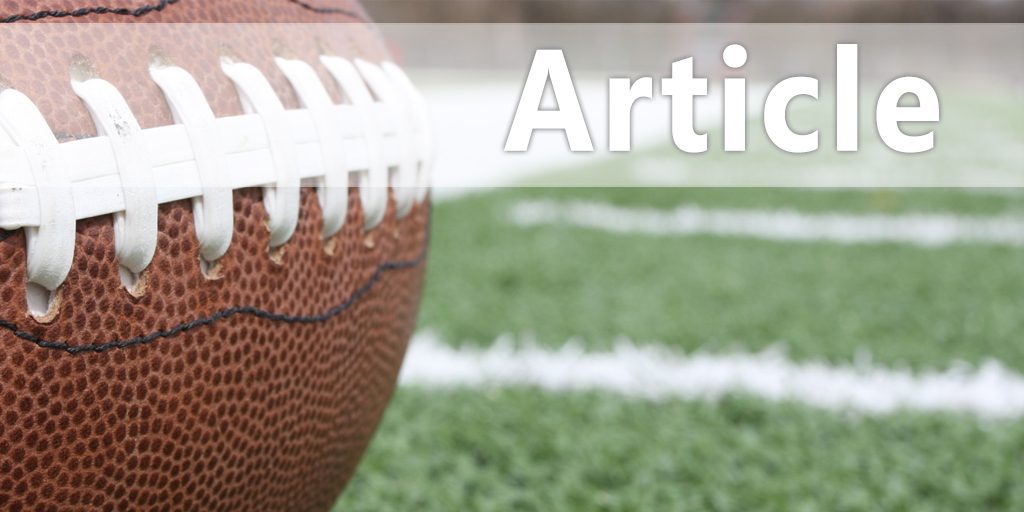


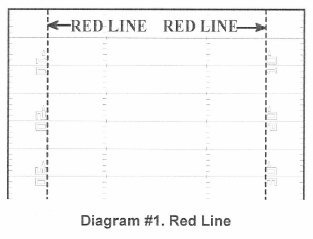 On offense, we consider the bottom of the numbers on the field the red line. (Diagram #1) It is a landmark on the field for our receivers and quarterbacks. This mark is six and one half yards from the sideline. What this tells our quarterback is if the receiver can get on top of the defender, he has six and one half yards of space to throw the fade. The quarterback knows he has a big window. If the defensive back does not allow the receiver to get on top and works the receiver off the red line and towards the sideline, the window is shrinking. For the quarterbacks, receivers and even defensive backs, the red line is a point of emphasis for us. If we are in one on one, team drills, or scrimmaging, in practice we make the red line a point of emphasis.
On offense, we consider the bottom of the numbers on the field the red line. (Diagram #1) It is a landmark on the field for our receivers and quarterbacks. This mark is six and one half yards from the sideline. What this tells our quarterback is if the receiver can get on top of the defender, he has six and one half yards of space to throw the fade. The quarterback knows he has a big window. If the defensive back does not allow the receiver to get on top and works the receiver off the red line and towards the sideline, the window is shrinking. For the quarterbacks, receivers and even defensive backs, the red line is a point of emphasis for us. If we are in one on one, team drills, or scrimmaging, in practice we make the red line a point of emphasis.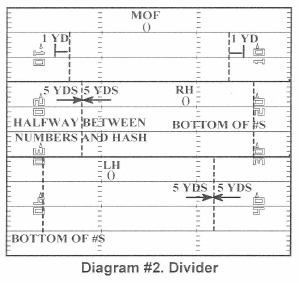
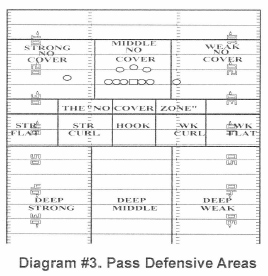
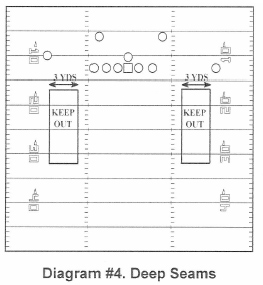
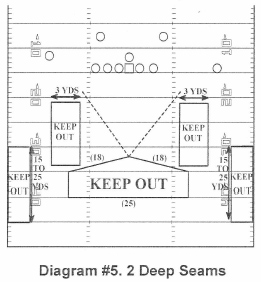 When talking about 2-Deep Seams, we want to keep the receivers from the middle of the field. The seams run the same way, but you do not want them to be able to run into the middle of the field. (Diagram #5) It is okay to re-route the number one and number two receivers and let them run into the seams at ten yards.
When talking about 2-Deep Seams, we want to keep the receivers from the middle of the field. The seams run the same way, but you do not want them to be able to run into the middle of the field. (Diagram #5) It is okay to re-route the number one and number two receivers and let them run into the seams at ten yards.